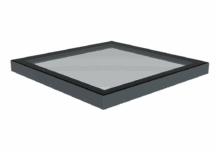
Beneficial for space-saving, energy efficiency and housing mechanical and electrical equipment, flat roofs are commonly specified for diverse applications across many sectors. Considering this, Will Wigfield, product manager – flat roof at ROCKWOOL UK, examines the role of the modern roof, discusses why it is susceptible to fire hazards, and offers best practice advice on how best to mitigate these.
Whether it is for an education building, industrial unit or high-rise apartment, flat roofs provide a versatile design solution and a valuable and practical commodity.
While flat roofs have long been used to house service and plant equipment, they are also now frequently designed to create green and blue roofs, harvest energy through PV arrays, and provide garden terraces amongst other uses.
Moreover, in many cases, the roof still needs to be considered as a means of escape within fire strategies and provide a safe place of refuge in the event of a fire.
However, the modern role of the roof makes it more susceptible to increased fire risk such as arson attacks, fire spread, hot works or plant failure.
When considering the well documented socio-economic impacts of a fire, it is therefore fundamental to consider the fire performance of the roof during early design.
Socio-economic impacts of roof fires
When fire spreads to the roof, there is a much greater risk of building collapse as compared to fires in other areas of the building. In situations where building collapse is avoided, fire in the roof usually leads to significant financial costs not limited to re-construction, service disruption, loss of stock and impact on employment.
Additionally, if the damaged building supports a public service, such as schooling or hospital care, the impact on the surrounding community can be even greater.
Recent roof fires highlight why minimising its spread is so important. The Ocado warehouse in Andover is one example of this1. The fire broke out on the factory floor due to a robotics fault, and eventually spread to the roof resulting in total building collapse. Fortunately, there was no loss of life, but there was considerable damage to the facility and stock– amounting to a financial cost of £110 million to Ocado.
With this in mind, understanding the threat of fire in roofs and identifying where risk can best be mitigated is the first step in prevention.
Reducing the risk
While Approved Document B sets minimum performance standards for building design to ensure the safe passage of exit for building occupants in the event of a fire, it does not provide design guidance on how to ensure the viability of the building and its contents post-fire.
To safeguard people and property in the event of a fire taking place in the roof, it is considered as best practice to specify and install a non-combustible insulation material. Not only helping to reduce heat loss in the roof, but non-combustible materials also deliver measurable protection against fire spread.
A simple and straightforward way to determine the combustibility of a building product is by confirming its Euroclass reaction-to-fire rating. A non-combustible material is defined by a Euroclass rating of A1 or A2-s1, d0*.
Non-combustible materials do not contribute to the spread of fire nor emit significant toxic smoke. Some non-combustible materials, stone wool insulation for example, have the ability to withstand temperatures in excess of 1,000°C. Helping to reduce damage to the roof, non-combustible insulation can minimise the impact of fire on the overall building fabric.
As the role of the modern roof continues to adapt and become more demanding, measuring risk and effectively mitigating this is the most effective way to safeguard people and property in the long-term.
Using non-combustible materials is not just a best-practice measure for ensuring effective risk management in today’s market, it also serves to futureproof buildings and specifications against changing client demands and an evolving regulatory landscape.
*Within the context of Approved Document B, a substrate or deck with a minimum classification of A2-s3, d2 is required at the junction with compartment walls.



